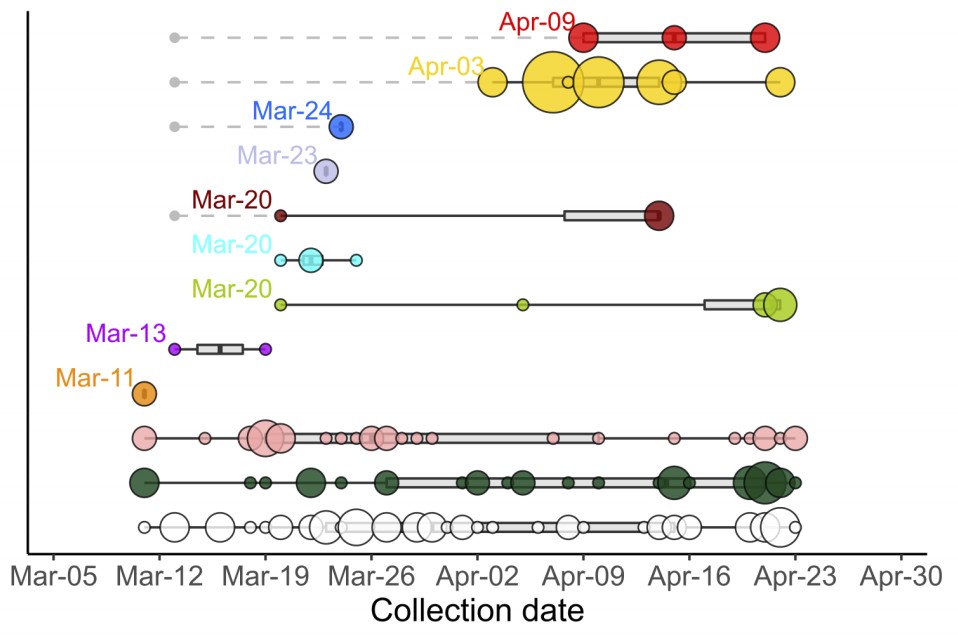Four research groups at Skoltech have received grants from the Russian Foundation for Basic Research (RFBR) for their COVID-19 research. We caught up with the grant winners to learn about their projects.
Georgii Bazykin, professor at the Center for Life Sciences (CLS)
Project: “Fundamental aspects of molecular epidemiology of SARS-CoV-2”
Professor Bazykin’s research group has been working on this topic since the onset of the pandemic.
“I believe that genomic epidemiology is a useful tool for combatting both the current and future pandemics. You should know what your enemy looks like and be able to tell one from another if they come en masse. Our project aims to find out how different are the virus varieties circulating in Russia, how they get from one region to another, what causes new outbreaks and how fast the virus spreads during such occurrences, whether the virus changes according to a specific pattern and whether changes in its genome affect its properties,” comments Georgii Bazykin.
Konstantin Lukyanov, professor at the Center for Life Sciences (CLS)
Project: “Genetically encoded fluorescent probes for studying the dynamics of intracellular transport and interaction of SARS-CoV-2 proteins and creating safe cellular screening platforms”.
“Our first objective is to look at the behavior of the virus’s newly synthesized membrane proteins in a living host cell, including its earliest stages that are beyond the reach of classical methods. As an outcome, we expect to get a detailed picture of the transport and interaction of the virus’s membrane proteins. Second, we plan to create fluorescent sensors for detecting the activity of the viral protease which cuts the coronavirus’s early proteins and modifies the cell’s proteins in a way helpful for the virus. In the future, such sensors will help to create platforms for high-throughput screening of protease inhibitors which would halt viral replication,” explains Konstantin Lukyanov.
Marat Kazanov, senior research scientist at the Center for Life Sciences (CLS)
Project: “Bioinformatic prediction and comparative genomic analysis of coronavirus proteolytic cleavage sites”
“We are investigating the role of the mysterious short DNA segment that was inserted in the gene of the coronavirus spike (S) protein and presumably coding a furin protease cleavage site (proteases are human enzymes that break down proteins and peptides). This DNA insertion may assumingly make the virus more pathogenic or contagious. The coronavirus spike (S) protein binds to the ACE2 human cell receptors and thus plays a critical role in the process of virus penetration into the human cell, while human proteases are presumably used by the virus to activate this process. To better understand the role of coronavirus cleavage sites, we are developing a bioinformatics tool for predicting these sites on proteins with a known 3D structure. We expect to use the tool for predicting cleavage sites for known coronaviruses and see if they are somehow linked to the virus pathogenicity and contagiousness using comparative genomics techniques,” says Marat Kazanov.
Alexey Yashchenok, leading research scientist at the Center for Photonics and Quantum Materials (CPQM)
Project: “A new approach for the treatment of viral respiratory tract infections, including SARS-CoV-2, based on targeted binding of vaterite particles containing encapsulated ribonuclease”
“Our project focuses on the development of a new approach to the treatment of the coronavirus infection using vaterite particles, a natural variety of calcium carbonate, containing ribonuclease – an enzyme that cleaves viral nucleic acid – and coated with a substance that selectively binds to the coronavirus’s surface protein S. We assume that the binding between viral particles and those we developed will either trigger the nonspecific immune response or stop viral replication. In the future, this approach can be extended to the treatment of other lower respiratory tract infections,” notes Alexey Yashchenok.
Contact information:
Skoltech Communications
+7 (495) 280 14 81

